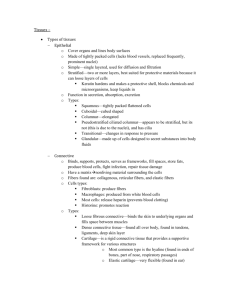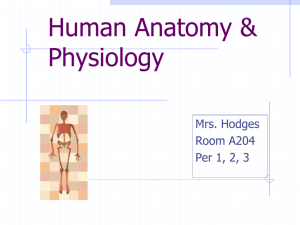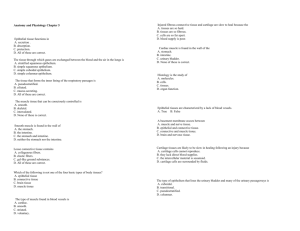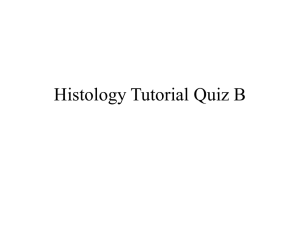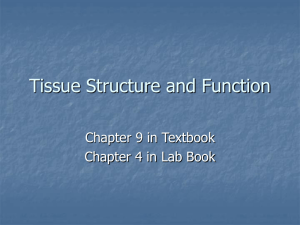Dense Connective Tissue
advertisement
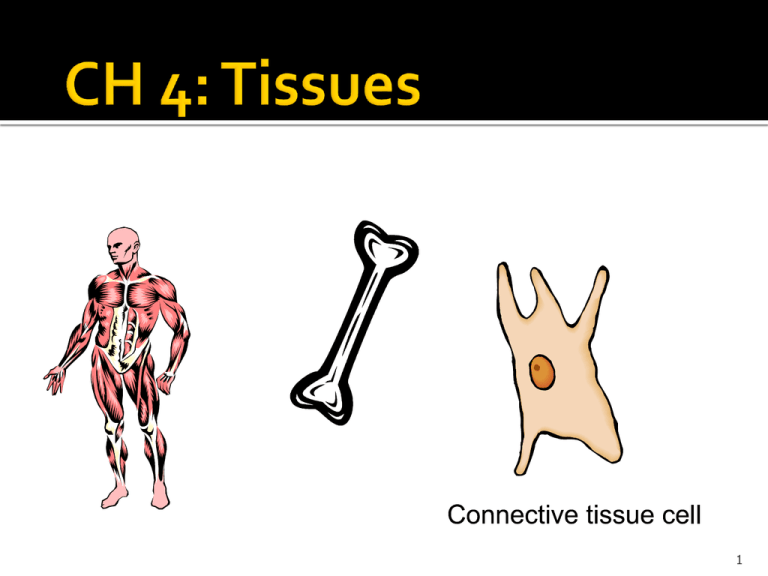
1 Tissues are groups of cells that are similar in structure and function. Tissues are organized into organs (heart, lungs, liver, kidneys…etc.) and can be a combination of different kinds of cells. Histology is the study of tissues. A pathologist is a scientist who specializes in cells and tissues in order to help physicians make a diagnosis. 2 Epithelial – COVER the body Connective – PROTECT and SUPPORT the body Muscle – MOVEMENT of the body Nervous – CONTROL of the body 3 Covers body surfaces and lines cavities, hollow organs and tubes. It also forms glands. Cells are closely packed and arranged in sheets of either single or multiple layers. Bottom surface of epithelium is attached to the basement membrane- fibers that are located between the epithelium and the connective tissue below it. 4 Avascular- without blood vessels. Epithelium gets nutrients from the adjacent connective tissue. Has a nerve supply. Is constantly being regenerated because it suffers so much wear and tear. Epithelium is classified by the cell shape, the number of cell layers, and other modifications. 6 Squamous Thin and flat and attach to each other like tiles. Cuboidal Shaped like cubes and produce important secretions (fluids) like sweat and mucus. Also absorb fluids like digested nutrients. 7 Columnar taller than wide and functions to protect underlying tissues and secrete and absorb fluids. Transitional Range from flat to columnar and often change shape due to stretching or movement of body parts. 8 Simple- - one layer - usually involved in absorption and/or diffusion Stratified- - many layers - Protects underlying tissues 9 Pseudostratified - Looks like many layers because not all cells reach the surface 10 Cilia- Tiny hairs that move substances around outside the cell Microvilli- Folds that increase surface area for absorption Goblet cells- embedded in between epithelium and secrete mucus for lubrication or to trap particles 11 Contains cells that secrete substances into ducts, onto a surface or in the blood. Exocrine Glands-Secrete substances via a duct. Examples include mucus, oil, earwax, saliva, and milk. Endocrine Glands- Are ductless and secrete hormones which diffuse into the bloodstream. 12 13 Simple squamous epithelium •Squamous cells have the appearance of thin, flat plates •They form the lining of cavities such as the mouth, blood vessels, heart and lungs and make up the outer layers of the skin. Simple Squamous – Top View – found in the walls of capillaries and alveoli of lungs Simple cuboidal epithelium • Cuboidal cells are roughly square or cuboidal in shape. • Each cell has a spherical nucleus in the centre. • Cuboidal epithelium is found in glands and in the lining of the kidney tubules as well as in the ducts of the glands. It functions in secretion and absorption. Simple Cuboidal Epithelial Tissue – this is of the collecting duct of the kidney Simple columnar epithelium • The cells are elongated and column-shaped. The nuclei are elongated and are usually located near the base of the cells. • Columnar epithelium forms the lining of the stomach and intestines and protects as well as secretes/absorbs. • Goblet cells (unicellular glands) are found between the columnar epithelial cells. They secrete mucus. Simple Columnar Epithelial Tissue - This is a cross section through the small intestine – for absorption – microvilli on surface of cells Stratified Squamous Epithelium •The superficial layers are squamous while the layers below may be cuboidal or columnar. This tissue makes up the top layer of skin and contains keratin- a waterproof protein. Nonkeratinized forms of this tissue are found in wet areas- inside the mouth, esophagus and vagina. Stratified Cuboidal Epithelium • Found in the ducts of adult sweat glands and part of the male urethra. This functions in limited secretion and absorption. Stratified Columnar Epithelium • The superficial cells only are columnar. The cells below are irregularly shaped. This tissue lines part of the urethra, the eye and the ducts of glands like the salivary. This tissue functions in protection and secretion. Pseudostratified Columnar • Not a true stratified tissue. The nuclei of the cells are at different levels. This functions in secretion and movement of mucus. It can be found in the upper respiratory tract where the tissue cells have cilia. It can also be found in the path that sperm take. Here the cells are not ciliated. Transitional Tissue • 3/23/2016 Bio 111-73 31 Most abundant and widely distributed tissue type Function in binding other tissues together and providing support Cells of connective tissue are embedded in a matrix , which is composed of a ground substance and fibers. Highly vascular Has a nerve supply (except cartilage) 38 Matrix is either solid, semi-solid or liquid type. The ground substance is the part of the matrix that takes up the space between cells and binds them together. Contains large molecules like hyaluronic acid, which is a slippery substance that lubricates joints and helps white blood cells move through connective tissue. Contains adhesion proteins which link parts of the ground substance together. 39 Fibers are another part of the matrix. Include collagen, elastic and reticular fibers. ▪ Collagen fibers give connective tissue flexibility and occur in parallel bundles. They are found in bone, cartilage, tendons and ligaments. ▪ Elastic fibers branch to form a network. They can be stretched up to 1 ½ times their relaxed state. They are found in skin, blood vessel walls and lung tissue. ▪ Reticular fibers are also branching. They help to form the basement membrane and are found surrounding fat cells, nerve fibers and some muscle tissue. 40 Fibroblasts- Most numerous connective tissue cells. Produce the fibers and ground substance of matrix. Macrophage- Type of white blood cell that engulfs bacteria. Plasma cells- Produce antibodies which fight foreign invaders. Mast cells- Produce histamine which dilates blood vessels during the body’s response to injury or infection. Adipocytes- Store fat 3/23/2016 Bio 111-73 41 There are 6 types of mature connective tissue. They include: loose connective tissue, dense connective tissue, cartilage, bone tissue, blood tissue and lymph. 42 43 Areolar Connective Tissue Makes up the subcutaneous layer just below the skin. Includes all 3 fiber types: collagen, elastic and reticular. Adipose Connective Tissue Contains adipocytes This is also found in the subcutaneous layer below the skin as well as around organs. 3/23/2016 Bio 111-73 44 Dense Connective Tissue contains more fibers and fewer cells. There are 3 types of DCT: Dense regular- Forms tendons and ligaments Dense irregular- Forms outer covering of bone, pericardium around the heart, and heart valves. Elastic connective- Lung tissue, walls of elastic arteries, trachea, and vocal cords. 45 Cartilage can endure more stress than loose and dense connective tissues. It’s resilience is due to the compound chondroitin sulfate. Cells of mature cartilage are called chrondrocytes. Avascular and lacks nerves Three types of cartilage: hyaline, fibrocartilage and elastic 3/23/2016 Bio 111-73 46 Appears in the body as a bluish-white, shiny substance. Chondrocytes are prominent when tissue is stained but fibers are not. Most abundant cartilage in the body. Weakest of the 3 types of cartilage. Found at the ends of ribs, the nose, and the trachea. Consists of chondrocytes scattered among bundles of collagen fibers. Located between vertebrae, where hip bones join on the anterior side and the cartilage pads of the knee. Chondrocytes are embedded in a threadlike network of fibers Located in the external ear and the epiglottis (flap of tissue that covers the trachea so food does not get in). • • Includes bone, the periosteum (outer covering), and bone marrow. Compact bone includes: • Lamellae- rings of mineral deposits (gives compact bone its strength • Lacunnae- spaces between lamellae • Haversian canals- In the middle of lamellae where blood vessels and nerves run. Has a liquid matrix called plasma. Plasma carries red blood cells- which transport oxygen and carbon dioxide. It also carries white blood cells that fight infection and platelets that participate in blood clotting. 52 Connective Tissues…. LOOSE CONNECTIVE TISSUE (Areolar) ADIPOSE TISSUE FIBROUS (DENSE) CONNECTIVE TISSUE HYALINE CARTILAGE FIBROCARTILAGE ELASTIC CARTILAGE BONE BLOOD Tissue Quiz… See how many You can correctly identify #1 #2 #3 #4 Muscle tissue consists of cells that are highly specialized to generate force. This force, produces motion, maintains posture, and generates heat. Muscle tissue cells have lots of mitochondria. Why? There are 3 types of muscle tissue. They are skeletal muscle, smooth muscle and cardiac muscle. 3/23/2016 Bio 111-73 75 76 Skeletal muscle is named for its location. It is attached to bones of the skeleton. Made of long cells called muscle fibers that attach to bones by connective tissue (tendon). Do you remember what kind of connective tissue? These cells are multinucleated. Proteins within skeletal muscle cells are very organized creating striations (alternating light and dark bands). In most cases, this type of muscle tissue is voluntary (consciously controlled). Can you think of a case when it is involuntary? 77 78 Smooth muscle is located in the walls of hollow internal structures such as blood vessels, airways to the lungs, the stomach, intestines, gall bladder and bladder. It constricts blood vessels, physically breaks down and moves food through the digestive tract and moves fluid through the body. Smooth muscle tissue is not striated and involuntary The cells of smooth muscle have 1 nucleus. 80 Cardiac muscle forms the bulk of the wall of the heart. Cardiac tissue is striated and involuntary. Cardiac muscle fibers are y-branched and have 1 nucleus. Cardiac muscle fibers are attached end to end by thickened membranes called intercalated disks. These hold the fibers together during contractions. 81 intercalated disk nucleus striations 82 83 Nervous tissue functions to convert stimuli into nerve impusles (electricity) and conduct these impulses to other nerve cells, muscle fibers or glands. The 2 types of nerve cells are neurons and neuroglia. Neurons conduct nerve impulses and neuroglia do not. 90 The neuron has 3 basic parts: Cell body- contains the nucleus and other organelles. Dendrites- many short branches off of the cell body that receive input. Axon- Single, long and thin extension off of the cell body that sends information to another neuron or other tissue. 3/23/2016 Bio 111-73 91 92

